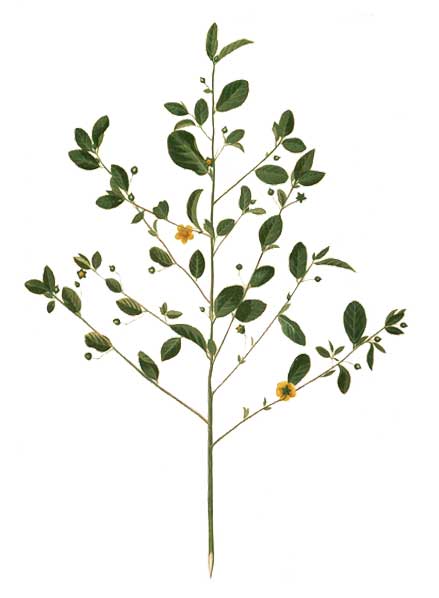
Family • Malvaceae
Ualis
Sida alnifolia var. alnifolia
JELLY LEAF
| Scientific names | Common names |
| Sida alnifolia var. alnifolia | Basbasot (Ilk.) |
| Sida retusa Linn. | Eskoba (Tag., C. Bis.) |
| Sida rhombifolia Linn. var. retusa (L.) Mast. | Eskobang-bilog (Tag.) |
| Sasaang-parang (Tag.) | |
| Siligun (C. Bis.) | |
| Ualis (Tag.) | |
| Jelly leaf (Engl.) | |
| Escoba / Escobilla / Eskuba/ Eskoba are common names confusingly shared by several Philippine medicinal plants: Sida acuta, Sida retusa (ualis), Scoparia dulcis (mala-anis), Sida rhombofolia (ualis-haba). | |
| Ualis / ualisualisan / ualis-haba are also confusingly shared root-words: Sida acuta, Sida retusa, Sida rhombofolia. | |
| Some compilations list S retusa and S rhombifolia as synonymous species; Quisumbing's compilation list them as separate species. | |
| Sida retusa L. is a synonym of Sida alnifolia var. alnifolia. The Plant List | |
| Sida alniflia var. alnifolia is an unresolved name. The Plant List | |
| Other vernacular names |
| JAPANESE: Yahazu kingojika. |
| RUSSIAN: Sida retuza, Sida prituplennaia. |
Distribution Properties Studies Availability |
© Godofredo U. Stuart Jr., M.D. |
Updated June 2018 / October 2013
![]()
 |
| IMAGE SOURCE / Public Domain / File:Sida sp Blanco2.248-original.png / Flora de Filipinas / Franciso Manuel Blanco (OSA), 1880-1883 / Wikimedia Commons (2) |
| Additional
Sources and Suggested Readings (1) CENTRAL NERVOUS SYSTEM EFFECTS OF SIDA RETUSA ROOT / Thangam Joseph and G Shanthaklmari / The Japanese Journal of Pharmacology, Vol.21 , No.1(1971)pp.136-13 (2) Sorting Sida names / Authorised by Prof. Snow Barlow / Maintained by: Michel H. Porcher / MULTILINGUAL MULTISCRIPT PLANT NAME DATABASE / Copyright © 1997 - 2000 The University of Melbourne. (3) ANTIOXIDANT POTENTIAL OF Sida retusa, Urena lobata AND Triumfetta rhomboidea / K.P. Lissy,* Thara K. Simon, and M.S. Latha / Anc Sci Life. 2006 Jan-Jun; 25(3-4): 10–15. PMCID: PMC3335214 (4) Sida alnifolia var. alnifolia / Synonyms / The Plant List (4) THE USE OF SIDA PLANT IN THE PREPARATION OF NAYAPAYAM KASHAYAM / M D Ajitha bai*, S P Sunitha Rani, S Balachandran, G Jayakumar / IJRAP, Jan – Feb 2012; 3(1) (5) Study of antihyperglycaemic activity of medicinal plant extracts in alloxan induced diabetic rats. / Attanayake AP, Jayatilaka KA, Pathirana C, Mudduwa LK / Anc Sci Life, April 2013; 32(4): pp 193-198 / doi: 10.4103/0257-7941.131970. (6) Evaluation of in vitro antioxidant activity of Sida rhombifolia (L.) ssp. retusa (L.) / Dhalwal K, Deshpande YS, Purohit AP / J Med Food, Dec 2007; 10(4): pp 683-688. (7) Central Nervous System Effects of Sida retusa Root / Thangam Joseph and G Shanthakumari / Short Communications / Japan Journal Pharmacol., (1971); 21: 137 (8) Hypoglycemic and Hypolipidemic Effect of Sida rhombifolia ssp. retusa in Diabetic Induced Animals / Kamlesh Dhalwal, Vaibhav M. Shinde*, Bhagat Singh, Kakasaheb R. Mahadik / International Journal of Phytomedicine, (2010); 2: pp160-165 (9) COMPARATIVE EVALUATION OF PRELIMINARY PHARMACOGNOSY AND PHYTOCHEMISTRY OF TWO SOURCE PLANTS OF BALA (SIDA CORDIFOLIA, LINN. AND SIDA RETUSA LINN.) / *Nimmy V S, P. Jayasreee, M. S Deepa / International Journal of Ayurveda and Pharma Research, Aug 2017; Vol 5, Issue 8 |
• |
 |
• |

 Botany
Botany